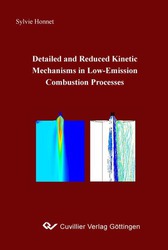| Areas | |
|---|---|
| Serie de libros (96) |
1378
|
| Nachhaltigkeit |
3
|
| Gesundheitswesen |
1
|
| Letra |
2364
|
| Ciencias Naturales |
5406
|
| Ciencias Ingeniería |
1793
|
| Ingeniería | 292 |
| Ingeniería mecánica y de proceso | 862 |
| Ingeniería eléctrica | 686 |
| Mineria y metalurgía | 30 |
| Arquitectura e ingeniería civil | 75 |
| General |
98
|
|
Leitlinien Unfallchirurgie
5. Auflage bestellen |
|
Erweiterte Suche
Detailed and Reduced Kinetic Mechanisms in Low-Emission Combustion Processes (Tienda española)
Sylvie Honnet (Autor)Previo
Indice, Datei (65 KB)
Lectura de prueba, Datei (110 KB)
The aim of this work is the application of the Representative Interactive Flamelet (RIF) model with detailed and reduced kinetics to describe the combustion processes with low-emission. Chemical kinetic reaction mechanisms are developed. Regarding the application of these mechanisms in the numerical simulation of combustion processes, the description of the formation of nitrous oxide is particularly taken into account.
After the introduction in the topic, chapter 2 presents the conservation equations and the description of the turbulent flow and mixing field. The flamelet model and the RIF-concept are described: the chemical reaction kinetics is separately considered from the flow dynamics. This is possible due to the assumption of the existence of a very thin flame layer, in which the chemical processes take place. This flame layer, also considered as laminar in turbulent flows, is called flamelet. The calculation of the ignition, heat release and formation of nitrogen oxide with detailed kinetics is then possible.
In chapter 3, a model for the calculation of three-dimensional combustion processes is presented. It is based on the flamelet model. To describe the formation of nitrous oxide, the consideration of the combustion as an unsteady process is very important. This is possible thanks to the use of unsteady flamelets. The flamelets are calculated interactive with the flow solver, each representative for a pathway of particle through the combustion chamber. The statistical way of fluid particle through the combustion chamber is described by the eulerian transport equations.
In chapter 4, a chemical reaction mechanism is developed and validated with comparison with experimental results. Special attention is paid to the methane mechanism with consideration of nitrous oxide formation. This mechanism is reduced with steady-state assumptions. Furthermore, a pyrolysis and burnout model are presented, which are used for the simulation of the coal combustion in chapter 5.
In chapter 5, simulation results for two different configurations are compared to experimental data. In the MILD combustion chamber, the formation of nitrous oxide is investigated with the use of the detailed and reduced kinetics presented in chapter 4. The Eulerian Particle Flamelet model is completed and used for the simulation of the gaseous phase during the coal combustion. Based on the results, it is shown that the flamelet model, coupled with the detailed and the reduced kinetics, is able to model low-emission combustion processes.
| ISBN-10 (Impresion) | 386727391X |
| ISBN-13 (Impresion) | 9783867273916 |
| ISBN-13 (E-Book) | 9783736923911 |
| Formato | A5 |
| Idioma | Inglés |
| Numero de paginas | 148 |
| Edicion | 1 |
| Volumen | 0 |
| Lugar de publicacion | Göttingen |
| Lugar de la disertacion | Aachen |
| Fecha de publicacion | 11.10.2007 |
| Clasificacion simple | Tesis doctoral |
| Area |
Ingeniería
|








